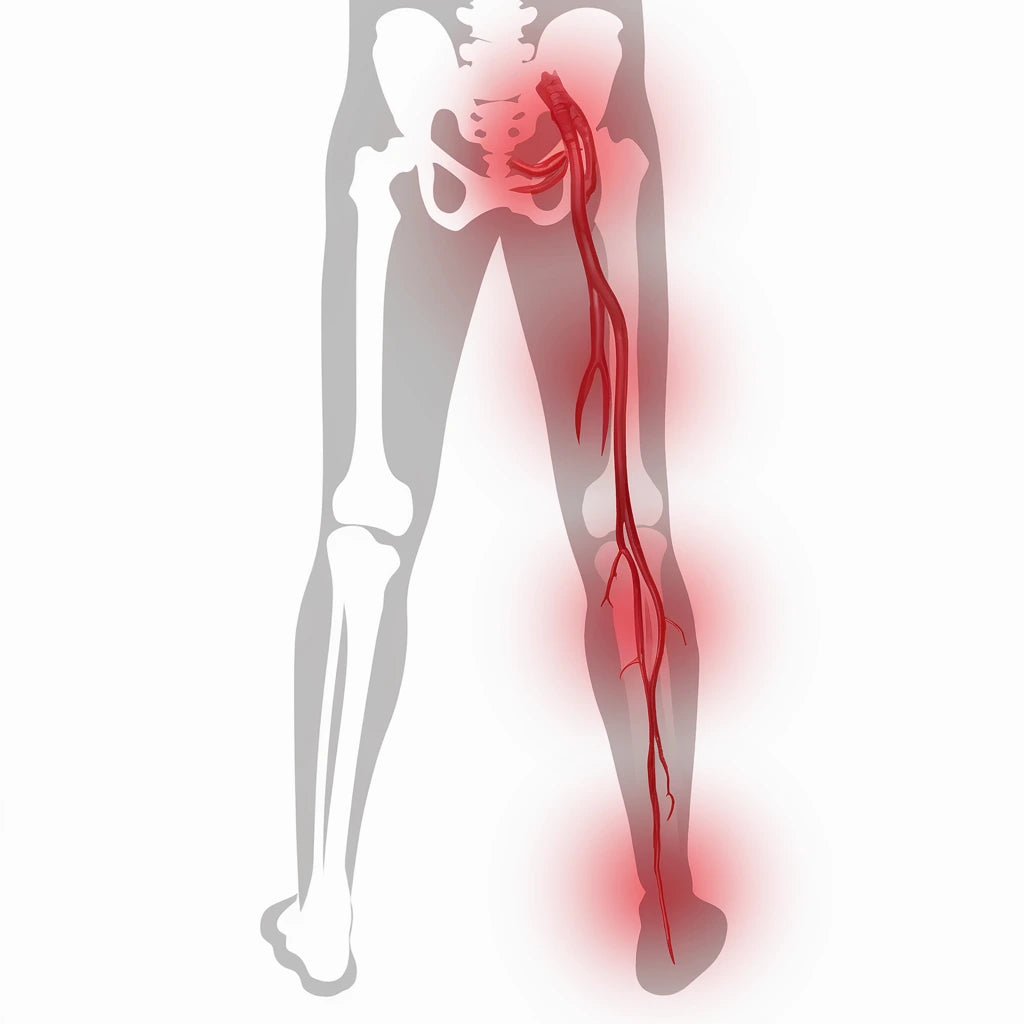Sciatica in the back: Symptoms, causes, and treatment

Sciatica is a painful condition that occurs when the sciatic nerve becomes irritated or pinched. It can cause everything from lumbago sciatica to tingling and pain in the calf sciatica. Here we go over common symptoms, causes and treatments, as well as how you can relieve the discomfort.
What is sciatica in the back?
Sciatica occurs when the sciatic nerve is irritated or pinched, causing nerve pain in the back , numbness and tingling down the leg. Causes include herniated discs, degenerative changes and muscle strain. Early treatment is important to relieve the discomfort. The sciatic nerve is the longest and thickest nerve in the body, running from the lower back, through the pelvis and down to the foot. When this nerve is subjected to pressure or irritation, it can lead to severe pain and other discomfort that is sometimes felt all the way down to the foot.
Symptoms of sciatica in the back
Common symptoms include:
- Pain in the lower back that radiates down the leg
- Numbness and tingling in the leg and foot
- Muscle weakness in the affected leg
- Increased pain when coughing, sneezing, or sitting
- Difficulty standing on tiptoe or walking
Back pain sciatica can also be called low back pain – symptoms or lumbago and is characterized by pain radiating from the back down the path of the nerve. Symptoms can range from mild to severe pain, depending on the degree of nerve involvement. Some people also experience stiffness and difficulty with movement, especially when trying to get up after sitting for a long time.
Causes of lumbago sciatica
Common causes include:
- Herniated disc in the lumbar spine
- Spinal stenosis (narrowing of the spinal canal)
- Spondylolisthesis (vertebral displacement)
- Piriformis syndrome
- Pregnancy
In the case of lumbago sciatica, a combination of back pain and nerve damage can cause both severe pain and limited mobility.
Treatment of sciatica in the back
Sciatica occurs when the sciatic nerve becomes irritated or pinched, which can cause pain that radiates from the lower back down into the legs. Relief often requires a combination of rest, movement, heat therapy, and back support.
A thorough examination by a healthcare provider can determine the cause of the pain and determine the correct treatment method.
Physiotherapy
Regular exercises and stretching help reduce muscle tension, increase blood flow, and improve mobility in the back.
Back Comfort™ provides extra support during exercise and helps maintain correct posture.
Pain relief
Anti-inflammatory medications can reduce swelling and pain caused by nerve compression. If necessary, pain-relieving ointments or gentle massage can supplement treatment.
Heat and cooling treatment
Heat helps relax tense muscles, while cold can reduce inflammation and pain.
Termoreliever™ offers both heating and cooling functions, making it particularly useful for sciatica in the back.
Backrest
An ergonomic backrest can relieve strain on the spine and reduce pressure on the sciatic nerve during the day.
Back Comfort™ contributes to better stability and support during both rest and movement.

How BackComfort™ and Termoreliever™ can help with sciatica in the back
BackComfort™ and Termoreliever™ offer several benefits for people with sciatica in the back:
- Back Comfort™ provides stability and support for the spine.
- Termoreliever™ offers both heat and cold therapy for pain relief
- The combination can help reduce pressure on the sciatic nerve
- The products can be used during daily activities for continuous support
The BackComfort™ works like a corset, providing support for the spine and helping to relieve pressure on areas where the nerve may be pinched. This is especially useful during activities that can cause pain, such as lifting or sitting for long periods of time. The Thermoreliever™ can be used to relieve pain by applying heat or cold directly to the affected area, which can help reduce inflammation and relax weaker muscles.
Conclusion
Sciatica can be a very painful and limiting condition, but with proper diagnosis and treatment, most people can experience significant improvements. By combining conservative treatment methods with the use of supportive aids such as BackComfort™ and Termoreliever™, many people can effectively manage their symptoms and improve their quality of life. It is important to consult a doctor for a correct diagnosis and individual treatment plan. In case of repeated complaints or long-term pain, you should also pay attention to stiff back causes that can worsen sciatica over time.
There is no simple cure for sciatica, but with proper treatment, symptoms usually resolve within three months. Being patient and continuing with the recommended measures even after the pain begins to subside is important to prevent the condition from recurring. If you have sciatica that recurs regularly, you should discuss long-term strategies with your healthcare provider.
Frequently Asked Questions (FAQ)
How long does sciatica in the back usually last?
The duration varies, but with the right treatment, many people can experience improvement within 4-6 weeks.
Why does sciatica cause back pain when coughing and sneezing?
Pressure in the spine increases when coughing and sneezing, which can irritate the pinched nerve.
How do I use RyggKomforten™ for sciatica?
Use the BackComfort™ according to the product instructions, usually during daily activities to provide support and stability to the back.
Can Termoreliever™ relieve sciatica pain?
Yes, Termoreliever™ can be used for both heat and cold therapy, which can help relieve pain and inflammation associated with sciatica.
When should I seek emergency medical attention for sciatica in my back?
Seek immediate medical attention if you experience severe pain, loss of bladder or bowel control, or significant weakness in your legs. This may indicate a stiff-back condition or other serious back problems.

